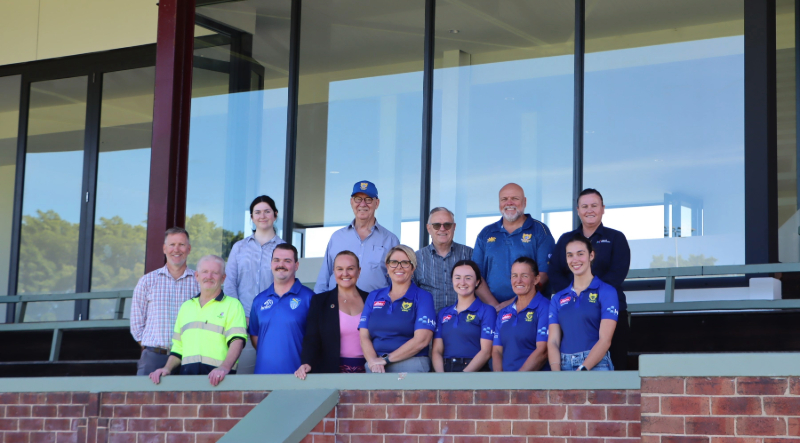The $658 million Sydney Children’s Hospital Stage 1 and Minderoo Children’s Comprehensive Cancer Centre has reached a major milestone, with construction of the new 12-storey building reaching its highest point.
Federal Minister for Health Mark Butler today joined NSW Minister for Health Ryan Park, Federal Member for Kingsford Smith Matt Thistlethwaite and Member for Coogee Dr Marjorie O’Neill for a traditional ‘topping out’ ceremony.
Honouring a long-held construction tradition, a Native Water Gum tree, which is native to the area, was lifted onto the roof of the new building.
The Sydney Children’s Hospital Stage 1 and Minderoo Children’s Comprehensive Cancer Centre is on track for completion in late 2025 and will include:
- a new and enhanced children’s intensive care unit
- a new and larger children’s emergency department
- a new medical short stay unit
- a new neurosciences centre
- a new virtual care centre and hospital command centre – KidsHQ
- inpatient units for medical, surgical and sleep studies
- a day oncology centre and inpatient units, along with a dedicated bone marrow transplant unit
- co-located laboratories to support the Minderoo Children’s Comprehensive Cancer Centre’s research, education and training
- a new children’s hospital pharmacy
- improved parent amenities, including an Aboriginal Gathering Space and overnight and oncology bereavement rooms
- education and training spaces.
The $658 million project is part of a $1.5 billion investment in health as part of the Randwick Health and Innovation Precinct.
The Minderoo Children’s Comprehensive Cancer Centre will include advanced laboratory spaces and deliver integrated, specialist cancer treatment, education and research, aiming to transform childhood cancer treatment and become one of the world’s leading paediatric cancer centres.
The NSW and Federal Governments have partnered with Children’s Cancer Institute, Sydney Children’s Hospitals Network including the Kids Cancer Centre, and UNSW Sydney to plan and deliver Australia’s first Children’s Comprehensive Cancer Centre within the new children’s hospital and university buildings on site.
Philanthropic contributions have also been provided from Sydney Children’s Hospitals Foundation, Minderoo Foundation and Children’s Cancer Institute.
The project is being delivered by Health Infrastructure, with John Holland as the principal contractor.
For more information visit the Randwick Campus Redevelopment – NSW Health website.
Federal Minister for Health Mark Butler said:
“This exciting milestone is another step towards delivering a state-of-the-art health facility which will transform paediatric care for generations to come.
“Once complete, the new health facility will be world-class, bringing together leading clinicians, researchers and educators under the one roof.”
NSW Minister for Health Ryan Park said:
“This is about significantly improving health outcomes for kids and their families, by offering them the highest level of care.
“This project will deliver a new children’s emergency department, emergency short-stay unit, and ICU and a new paediatric virtual care centre which will provide care to patients across the state.
“There has been extensive consultation to develop this new building with over 1000 people involved, to ensure we deliver a space which feels like home to families facing their toughest times.”
Federal Member for Kingsford Smith Matt Thistlethwaite said:
“With the project reaching its highest point now, our community has a better idea of just what will be on offer when the new hospital is completed.
“This redevelopment of Sydney Children’s Hospital has created more than a thousand jobs, which is a really welcome boost to our local economy.”
Member for Coogee Marjorie O’Neill said:
“I am very proud of this major investment in paediatric healthcare for our community here in Randwick and in surrounding areas, which is now coming to fruition.
“There are extraordinarily talented and committed healthcare staff who work here, so it’s terrific that they will have these state of the art facilities to provide great care to our community.”

 Lord Mayor Nuatali Nelmes joins CN staff, President of Hamilton Hawks Rugby Union Club Lesa Mason, Hawks players and officials, Hamilton-Wickham Cricket Club secretary Paul Rodgers and EJE Architecture representatives at the new-look Passmore Oval grandstand.The changerooms are housed within a new two-storey building constructed at the back of the existing grandstand, which also provides accessible amenities and viewing areas for both Passmore Oval and its adjacent Hawkins Oval.
Lord Mayor Nuatali Nelmes joins CN staff, President of Hamilton Hawks Rugby Union Club Lesa Mason, Hawks players and officials, Hamilton-Wickham Cricket Club secretary Paul Rodgers and EJE Architecture representatives at the new-look Passmore Oval grandstand.The changerooms are housed within a new two-storey building constructed at the back of the existing grandstand, which also provides accessible amenities and viewing areas for both Passmore Oval and its adjacent Hawkins Oval.